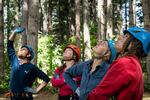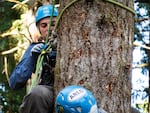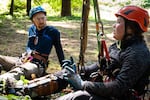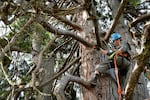Tree climbing is an indispensable component of forestry work, serving as a vital means to access the canopy. In the Northwest, pine cone collection is one of the primary reasons for tree climbing. Without the ability to collect cones, scientists would face significant challenges in understanding tree health, and reestablishing forests would be an arduous task.
But cone collection is dangerous work and involves maneuvering in some of the world’s tallest trees. As a result, the U.S. Forest Service mandates that all climbers acquire proper certification.
Tree climbing school, located in Cottage Grove, Oregon, is a four-day crash course in tree climbing that takes place every June. The event hosts some of the country’s most skilled climbers and climbing instructors, drawing in students from all over the U.S. who work as biologists, arborists, technicians, and even smoke jumpers. Skill levels range from experienced climbers to absolute beginners.
Brock Mayo, a tree climbing coordinator, oversees the daily activities and helped develop the curriculum.
“We get such a wide variety of instructors coming from all across the country,” he says. “A lot of knowledge is shared during that week.”

Tree climbing school participants (from left) Chad Marks-Fife, Megan Schaap, Alaina Makowski and Emily Boes scan a pine tree for abnormalities in Cottage Grove, Ore., on June 14, 2023.
Noah Thomas / OPB
Forest Service employees Alaina Makowski and Megan Schaap are eager to expand their skill sets and venture into cone collection, but neither has any climbing experience. They decided to enroll in the tree climbing school in hopes of obtaining their climbing certifications.
“I have never climbed before,” Makowski says. “This will be my first time up in a tree like this.”
In the late 1970s, the Forest Service recognized the need for establishing national tree climbing standards. Given Oregon’s rich tradition in forestry work, it seemed like a natural home base. And just like that, the tree climbing school was born.
The first ascent
When learning to climb trees, it helps to have an experienced instructor. Someone like Chad Marks-Fife, who’s been climbing for more than 15 years. Over the next four days, Marks-Fife will provide Makowski and Schaap with a comprehensive and demanding introduction to the world of tree climbing.
“My particular teaching style is very in the tree,” Marks-Fife says. “There is only so much I can tell you on the ground.”
Professional climbers are routinely 100 feet off the ground, often with heavy gear strapped to their harnesses. They climb using ropes that are looped around thick and sturdy branches. Climbers attach themselves to the ropes using a series of complex knots.
After a thorough safety discussion, Marks-Fife demonstrates one of these knots — the Blake’s hitch moving rope system, which is a foundational technique in tree climbing. While it’s relatively easy to grasp, it requires considerable exertion from climbers ascending the tree.
“This is all about safety,” he says. I don’t want you clinging to the tree thinking, ‘If I let go of this, I’m falling out.’ You will always be strapped to something safe.”
For Schaap, this is a reassuring statement. In addition to cone collection, the school will provide an opportunity to face a lifelong phobia.
“I wanted to be able to overcome a fear of heights that I have,” says Schaap. “Just being able to be high up in a tree and not be scared.”

Chad Marks-Fife climbs a cedar on June 13, 2023.
Noah Thomas / OPB
Marks-Fife begins ascending the tree using a whole-body thrusting motion which is necessary with the Blake’s hitch system. Schaap and Makowski watch intently as he talks them through the process.
“Arch your back like that, and then push up,” he says. “It’s going to look like you’re kind of humping your way up this tree. That’s just what it is.”
After Marks-Fife lowers himself down, Schaap attaches the rope to her harness and begins her ascent. She struggles to gain much elevation as the technique is difficult to master for first-time climbers.
“Climbing can be overwhelming,” says Marks-Fife. “Especially in a setting here where they have one week to learn what is a lifetime of knowledge.”
Fighting through a combination of fear and exhaustion, Schaap and Makowski are able to successfully ascend the tree and reach a large limb about 30 feet up. Makowski completes a limb-walking exercise while Schaap’s fear of heights keeps her glued to the tree trunk.
“That was fun, but so scary,” Schaap says. “I think the more I do it, the better I’ll feel about it.”
Going out on a limb
On days two and three, the students learn more rope climbing techniques and are introduced to the physically demanding skill of spur climbing, which involves climbing a tree using 3-inch spikes (or spurs) strapped to your feet.
Marks-Fife decides to dedicate the fourth day to teaching the static rope climbing system. This system, widely employed by professional climbers, offers a more contemporary approach to tree climbing, enabling climbers to ascend and descend trees quickly.

Alaina Makowski attempts a mock rescue during a spur climbing exercise on June 14, 2023.
Noah Thomas / OPB
Marks-Fife asks Schaap to lead the exercise. Up until now, she’s been too afraid to complete a limb walk.
“I want to make sure that she can work her way out to the place where the cones are actually growing in the tree,” Marks-Fife says.
Schaap makes it up the tree and stands on a branch tightly hugging the trunk.
“My feet are shaking,” exclaims Schaap.
“Kick it out,” answers Marks-Fife. “Give me a little foot kick. There you go.”
Schaap gingerly removes one of her feet from the branch and shakes it out.
Schaap has to trust that this rope system she only learned a few minutes ago will hold her safely in the tree. Trusting that the rope won’t fail requires immense mental strength, especially for new students who are still acclimating to the challenges of tree climbing.
Eventually Schaap is able to walk out onto the limb and complete the exercise. She returns to the ground breathing heavily.
“Oh my god. That was probably the most terrifying thing I’ve ever done,” she says. “I’m really happy that I didn’t bail and I got it done.”

Chad Marks-Fife, left, and Megan Schaap debrief after a difficult climbing exercise on June 15, 2023.
Noah Thomas / OPB
The journey ahead
Following four days of rigorous climbing exercises, Marks-Fife commends Makowski and Schaap for their dedication and hard work.
However, he informs them that additional hours of training will be required before they can obtain their certifications. This is common for the majority of new climbers, as a certification demands comprehensive knowledge and practical skills in diverse climbing situations.
Both Makowski and Schaap are eager to continue their training in hopes of being certified in the future.
“I definitely want to keep climbing,” Schaap says. “I want to be able to just walk up that tree and feel really confident and really secure, and be able to just really enjoy being up there.”
“I think I’m hooked,” Makowski says. “I think I need more practice and I need to get more comfortable, but once that’s down, hanging out up there is just a blast.”

Student Emily Boes performs a limb walking exercise on June 13, 2023.
Noah Thomas / OPB
